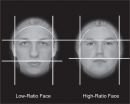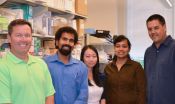(Press-News.org) Geneticists at Heidelberg University Hospital's Department of Molecular Human Genetics have used a new mouse model to demonstrate the way a certain genetic mutation is linked to a type of autism in humans and affects brain development and behavior. In the brain of genetically altered mice, the protein FOXP1 is not synthesized, which is also the case for individuals with a certain form of autism. Consequently, after birth the brain structures degenerate that play a key role in perception. The mice also exhibited abnormal behavior that is typical of autism. The new mouse model now allows the molecular mechanisms in which FOXP1 plays a role to be explained and the associated changes in the brain to be better understood.
"While these kinds of results from basic research cannot be directly translated into treatment, they are still quite valuable for the affected individuals or in this case, for their parents and family. For many of them, it is important to be able to specifically put a name to the disorder and understand it. It can make dealing with it easier," said Professor Gudrun Rappold, Head of the Department of Molecular Human Genetics at Heidelberg University Hospital and senior author of the article. The results have now been published in a preliminary online version in the journal Molecular Psychiatry in cooperation with Miriam Schneider, Institute of Psychopharmacology at the Central Institute of Mental Health in Mannheim, and Dr. Corentin Le Magueresse, German Cancer Research Center (DKFZ) and Professor Hannah Monyer, Department of Clinical Neurobiology, Heidelberg University Hospital and DKFZ in Heidelberg.
Autism is a congenital perception and information-processing disorder in the brain that is frequently accompanied by intellectual disability and in rare cases, superior intelligence and special gifts such as photographic memory. The disorder is characterized by limited social interaction, repetitive behavior and language impairment. Furthermore, a wide range of other disturbances can occur. "Today, in addition to the defect in the FOXP1 gene, we are familiar with other genetic mutations that cause autism or increase the risk of this kind of disorder. However, we are only able to understand how they affect the molecular processes in the neurons, brain development and behavior for a few of these mutations," Rappold said.
This is also the case for FOXP1. Back in 2010, clear signs that structural flaws in this protein play a role in autism and mental disability had been discovered. But what role does it play in the healthy brain? What signal pathways is it involved in? Which other proteins does it interact with and exactly what damage is caused by its absence? The new mouse model has helped to shed light on these questions. The researchers discovered that the mice were born with a normally developed brain for the most part. During the course of the first weeks of life, the striatum, which is important for perception and behavior, degenerates. In a centrally located brain structure as well - the hippocampus - which is indispensable for developing long-term memory and recall, microscopically visible changes occur that can also impact signal processing. It could be proven, for example, that in the affected neurons the impulse conduction is changed through which signals are transmitted between neurons.
In addition to the striatum, the ventricles of the brain are degenerated; these are adjacent structures in the murine brain. "Enlarged ventricles were also detected in humans with a FOXP1 mutation," explained Dr. Claire Bacon, who works in the Molecular Human Genetics Department and is first author of the publication. The changes also trigger abnormal behavior that is comparable to the symptoms of autistic patients. The mice barely noticed their fellow mice and did not attempt to make contact to them. Further symptoms include stereotypical compulsive repetitive behaviors, hyperactivity and disturbed nestbuilding behavior.
The researchers now intend to study to what extent the communication of noise by FOXP1 mice (mice communicate via noises in the ultrasonic range) is impaired and whether there are also parallels to the disturbances in patients with FOXP1 mutation in this area as well. In addition, they plan to characterize the newly identified genes impacted by the FOXP1 in the brain and find out which signaling cascades and response paths are disrupted. In this way, they hope to find starting points for a specific treatment. "However, we first have to understand exactly how these changes occur before we can develop treatment concepts," Rappold stressed.
INFORMATION:
Literature:
Brain-specific Foxp1 deletion impairs neuronal development and causes autistic-like behaviour. Bacon C, Schneider M, Le Magueresse C, Froehlich H, Sticht C, Gluch C, Monyer H, Rappold GA. Mol Psychiatry. 2014 Sep 30. doi:10.1038/mp.2014.116. [Epub ahead of print]
The distinct and overlapping phenotypic spectra of FOXP1 and FOXP2 in cognitive disorders. Bacon C, Rappold GA Hum Genet. 2012;131(11):1687-98.
More information is available on the Web:
Department of Molecular Human Genetics
http://www.klinikum.uni-heidelberg.de/Abt-Molekulare-Humangenetik.6096.0.html
Website of the FOXP1 Community
http://www.rareconnect.org/en/community/foxp1/understand
Heidelberg University Hospital and Medical Faculty:
Internationally recognized patient care, research, and teaching
Heidelberg University Hospital is one of the largest and most prestigious medical centers in Germany. The Medical Faculty of Heidelberg University belongs to the internationally most renowned biomedical research institutions in Europe. Both institutions have the common goal of developing new therapies and implementing them rapidly for patients. With about 12,600 employees, training and qualification is an important issue. Every year, around 66,000 patients are treated on an inpatient basis and around 1.000.000 cases on an outpatient basis in more than 50 clinics and departments with 1,900 beds. Currently, about 3,500 future physicians are studying in Heidelberg; the reform Heidelberg Curriculum Medicinale (HeiCuMed) is one of the top medical training programs in Germany.
http://www.klinikum.uni-heidelberg.de
Requests by journalists:
Julia Bird
Corporate Communication/Public Relations
University Hospital and
Medical Faculty of Heidelberg
Im Neuenheimer Feld 672
69120 Heidelberg
Germany
phone: +49 6221 / 56 70 71
fax: +49 6221 / 56 45 44
e-mail: Julia.bird@med.uni-heidelberg.de
Selected english press releases online:
http://www.klinikum.uni-heidelberg.de/presse
An electronic "tongue" could one day sample food and drinks as a quality check before they hit store shelves. Or it could someday monitor water for pollutants or test blood for signs of disease. With an eye toward these applications, scientists are reporting the development of a new, inexpensive and highly sensitive version of such a device in the journal ACS Applied Materials & Interfaces.
S. V. Litvinenko and colleagues explain that an electronic tongue is an analytical instrument that mimics how people and other mammals distinguish tastes. Tiny sensors detect substances ...
The structure of a soccer player's face can predict his performance on the field--including his likelihood of scoring goals, making assists and committing fouls--according to a study led by a researcher at the University of Colorado Boulder.
The scientists studied the facial-width-to-height ratio (FHWR) of about 1,000 players from 32 countries who competed in the 2010 World Cup. The results, published in the journal Adaptive Human Behavior and Physiology, showed that midfielders, who play both offense and defense, and forwards, who lead the offense, with higher FWHRs ...
Queensland University of Technology (QUT) researchers have found the habit of Googling for an online diagnosis before visiting the doctor can be a powerful predictor of infectious diseases outbreaks.
Now studies by the same Brisbane-based researchers show combining information from monitoring internet search metrics such as Baidu (China's equivalent of Google), with a web-based infectious disease alert system from reported cases and environmental factors hold the key to improving early warning systems and reducing the deadly effects of dengue fever in China.
Dr Wenbiao ...
A new peer-reviewed study found that people are contaminated with several toxic flame retardants rarely studied in the US, including one that has never before been detected in Americans called TCEP. Scientists tested urine samples of California residents for biomarkers of six chemicals, all of which were present.
The scientists discovered a way to test for this class of toxic flame retardants (phosphates), which could open up a new wave of research into a group of pervasive flame retardants that were previously not studied nearly as much as some other flame retardants. ...
Depression causes an average of 10 lost working days per episode
Managers report need for better legislation, training and counseling to tackle the problem
Right Direction Initiative developed to increase awareness of depression, reduce stigma associated with the disease in the workplace, and encourage employees to increase help-seeking behaviors
Canton, Ohio- November 12, 2014 - Nearly a quarter (23 percent) of U.S. respondents indicated they have been diagnosed with depression in their lifetime and two in five (nearly 40 percent) of those patients reported taking ...
Cities have more species diversity than you'd expect. A study of ants in Manhattan found not only a wide range of species, but also significant differences in the levels of biodiversity in different urban areas.
"People don't think of cities as having ecology, and urban environments haven't been well studied," says Dr. Amy Savage, a postdoctoral biological sciences researcher at North Carolina State University and lead author of a paper on the work. "But protected areas, such as national parks, have been well studied. So we wanted to see if the theories developed to predict ...
ANN ARBOR, Mich. -- There's a cast of characters deep inside your ears -- many kinds of tiny cells working together to allow you to hear. The lead actors, called hair cells, play the crucial role in carrying sound signals to the brain.
But new research shows that when it comes to restoring lost hearing ability, the spotlight may fall on some of the ear's supporting actors - and their understudies.
In a new paper published online first by the Proceedings of the National Academy of Sciences, researchers from the University of Michigan Medical School, St. Jude Children's ...
New insights into how plants regulate their absorption of an essential nutrient could help avoid pollution caused by excess use of fertiliser.
The findings could lead to the development of crop varieties that need less of the primary nutrient - nitrogen - than conventional crops. It could also inform how much nitrogen should be added to plant feed.
This would allow optimum plant growth without producing excess nitrogen in run-off from fields, which is a major source of water pollution.
Agricultural fertilisers typically contain high levels of nitrogen that boost ...
JUPITER, FL, November 12, 2014 - In a pair of related studies, scientists from the Florida campus of The Scripps Research Institute (TSRI) have identified a number of new therapeutic targets for memory disorders and have developed a new screening test to uncover compounds that may one day work against those disorders.
The two studies, one published in the journal Proceedings of the National Academy of Sciences (PNAS), the other in the journal ASSAY and Drug Development Technologies, could lead new approaches to some of the most problematic diseases facing a rapidly aging ...
Medicine is drifting towards a major problem. An increasing number of bacteria is no longer sensitive to known antibiotics. Doctors urgently need to find new ways of fighting these multi-resistant pathogens. To address the problem, pharmaceutical research is turning back to the source of most of our drugs: nature.
Although hundreds of thousands of known active agents are found in nature, exactly how most of them work is unclear. A team of researchers from ETH Zurich has now developed a computer-based method to predict the mechanism of action of these natural substances. ...



